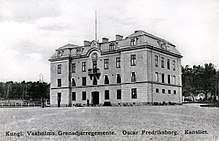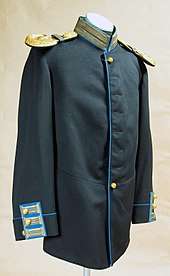Vaxholm Grenadier Regiment
| Vaxholm Grenadier Regiment | |
|---|---|
| Vaxholms grenadjärregemente | |
| Active | 1902–1927 |
| Country |
|
| Allegiance | Swedish Armed Forces |
| Branch | Swedish Army |
| Type | Infantry regiment |
| Size | Regiment |
| Part of |
IV Army Division (1902–1927) Göta Life Guards (1928–1939) |
| Garrison/HQ | Vaxholm |
| Colors | Light blue |
| March | "Schneidige Truppe" (Lehnhardt)[1] |
Vaxholm Grenadier Regiment (Swedish: Vaxholms grenadjärregemente), also I 26, was a Swedish Army infantry regiment that was active in various forms 1902–1927. The unit was based on Rindö in Vaxholm.[2][3][4]
History
The Vaxholm Grenadier Regiment was formed in 1902 according to the Defence Act of 1901 as a merger of Värmland Rifle Corps (Värmlands fältjägarkår, I 26) and Halland's Battalion (Hallands bataljon, I 28). The regiment initially received two battalions, but was increased by the Defence Act of 1914 with a third. It received its conscript crew from Stockholm's enrollment area. The regiment was part of the Vaxholm Fortress crew.[5]
As part of the Defence Act of 1925, the regiment was disbanded on 31 December 1927. However, on 1 January 1928, was raised again as a reduced archipelago infantry battalion included in the Göta Life Guards (I 2) under the name of Göta Life Guards Fortress Battalion (I 2 V). The battalion maintained its location in Vaxholm and consisted of a battalion staff and three companies (Life Company, 2nd Company and Machine Gun Company).[6] The battalion was under two authorities, where administration and training were under the responsibility of Göta Life Guards. For war planning and mobilization, the battalion sorted under the commandant of Vaxholm Fortress, which was an officer from the Swedish Navy. By the Defence Act of 1936, the battalion was disbanded together with Göta Life Guards on 30 September 1939.[6]
Barracks and training areas

The regiment was originally placed in Livgardet till häst (K 1) old barracks in Stockholm, but moved already in 1906 to Rindö east of Vaxholm.[4] The regimental barracks for I 26 on Rindö was completed in 1907 after Erik Josephson's drawings for the Swedish infantry. In 1941, the barracks of Vaxholm Grenadier Regiment became part of Vaxholm Coastal Artillery Regiment (KA 1).[7]
Heraldry and traditions
The color of the regiment was light blue and it carried the flags of both Värmland Rifle Corps (Värmlands fältjägarkår, I 26) and Halland's Battalion (Hallands bataljon, I 28).[2]
Commanding officers
Regimental commanders active in the regiment 1902–1927.[3]
- 1901–1914 – Ture Wickström
- 1914–1919 – Tell Schmidt
- 1919–1926 – Fredrik Löwenborg
- 1926–1927 – Olof Thörnell
Names, locations and designations

| Kungl Vaxholms grenadjärregemente | Royal Vaxholm Grenadier Regiment | 1902-01-01 | – | 1927-12-31 |
| Kungl Göta livgardes fästningsbataljon | Royal Göta Life Guards Fortress Battalion | 1928-01-01 | – | 1928-03-31 |
| Stockholm (L) | 1902-01-01 | – | 1906-08-31 |
| Rindö (L) | 1906-09-01 | – | 1939-09-30 |
| Myttinge skjutfält (T) | 1906-09-01 | – | 1939-09-30 |
| I 26 | 1902-01-01 | – | 1927-12-31 |
| I 2 V | 1928-01-01 | – | 1939-09-30 |
See also
References
| Wikimedia Commons has media related to Vaxholm Grenadier Regiment. |
Notes
- ↑ Sandberg 2007, p. 210
- 1 2 Braunstein 2005, pp. 109-110
- 1 2 Kjellander 2003, p. 324
- 1 2 Holmberg 1993, p. 16
- ↑ Westrin 1921, p. 929
- 1 2 Östlund 1980, pp. 83-89
- ↑ Vasallen 2007, p. 10
- Braunstein, Christian (2003). Sveriges arméförband under 1900-talet. Skrift / Statens försvarshistoriska museer, 1101-7023 ; 5. Stockholm: Statens försvarshistoriska museer. ISBN 91-971584-4-5. LIBRIS 8902928.
- Holmberg, Björn (1993). Arméns regementen, skolor och staber: [en uppslagsbok] : en sammanställning (in Swedish). Arvidsjaur: Svenskt militärhistoriskt bibliotek (SMB). ISBN 91-972209-0-6. LIBRIS 7796532.
- Kjellander, Rune (2003). Sveriges regementschefer 1700-2000: chefsbiografier och förbandsöversikter (in Swedish). Stockholm: Probus. ISBN 91-87184-74-5. LIBRIS 8981272.
- Sandberg, Bo (2007). Försvarets marscher och signaler förr och nu: marscher antagna av svenska militära förband, skolor och staber samt igenkännings-, tjänstgörings- och exercissignaler (in Swedish) (New ed.). Stockholm: Militärmusiksamfundet med Svenskt marscharkiv. ISBN 978-91-631-8699-8. LIBRIS 10413065.
- Berg, Ejnar (2004). Vyer från kastaler, kastell och kaserner: guide över Sveriges militära byggnader : illustrerad med vykort (in Swedish). Stockholm: Probus. ISBN 91-87184-75-3. LIBRIS 9818451.
- Östlund, Nils, ed. (1980). Kungl. Göta livgarde 1901-1980: ett regemente i tiden går ur tiden (in Swedish). Enköping: Göta livgardes historiekomm. LIBRIS 8202864.
- Westrin, Theodor, ed. (1921). Nordisk familjebok: konversationslexikon och realencyklopedi. 31 (New, rev. and rich ill. ed.). Stockholm: Nordisk familjeboks förl. LIBRIS 8072220.
Web
- "Kulturmiljöinventering av f.d. Kustartilleriregemente KA 1 vid Oscar Fredriksborg på Rindö, Vaxholm" (in Swedish). Vasallen, Nyréns Arkitektkontor. 12 January 2007. Archived from the original (PDF) on 2 January 2013. Retrieved 13 December 2017.